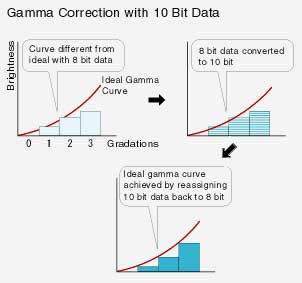The Eizo S2110W supposedly offers 14 bit colour in their spec here: http://www.eizo.com/products/lcd/S2110W/index.asp
The 14 bit is the internal colour processing system. The panel is a 8-bit like other LCD monitors

This example by Eizo is a good example:

Thanks for the video. To me it looks like the black level really increases even with just a small image (cursor) on the screen. Does fluctuating the backlight shorten its life?
Yeah. I thought it was strange that a cursor could determine whether to intensify the backlight or not. The largest part was black and to me it would seem logical to keep the brightness down unless a larger white image appeared.
LG still have some improvement to work on.
It doesn’t shorten the lifetime significantly. It might have some role but nothing important to speak of.
Was the conclusion that the TNs with DFC technology were just as good as the MVA and PVA screens (except for viewing angle) and faster? (Assuming MVA and PVA screens were 6-bit.)
I still find PVA and MVA's better. The optimized contrast ratio wasn't as good as a "real" high contrast ratio.
How many twists can crystals do? Will we ever see '10-bit' TFTs?
Probably. But a number of modifications have to be made. We need to see new ways of transporting the signal, higher bandwidth in cables, new circuit boards, better panels and not to mention a much higher colour gamut. This cannot be achieved without using some sort of alternative backlight. It could be LEDs but it still takes a lot of development.
Also, I wonder if there are any patterns that could identify a 6 bit vs. an 8 bit.
Connectors on LCD monitors are 8-bit. The monitor needs all the information in order to do the dithering.
You can try smooth gradients but it's still hard to see. We use it when testing monitors and you'll see some vertical "lines" in the picture on TN panel. It's harder to spot on PVA and MVA and one could mistake it for minor problems with rendering all shades.
The intelligent part of magic tune dos change according to the picture on the screen, if windows media player is activated then the image change on my 970p, but I guess it still isn’t quit the same
You must be referring to the dynamic profiles in the MagicTune. It's not the exactly same but I see your point. It doesn't, however, prove to be as effective as the DFC.

